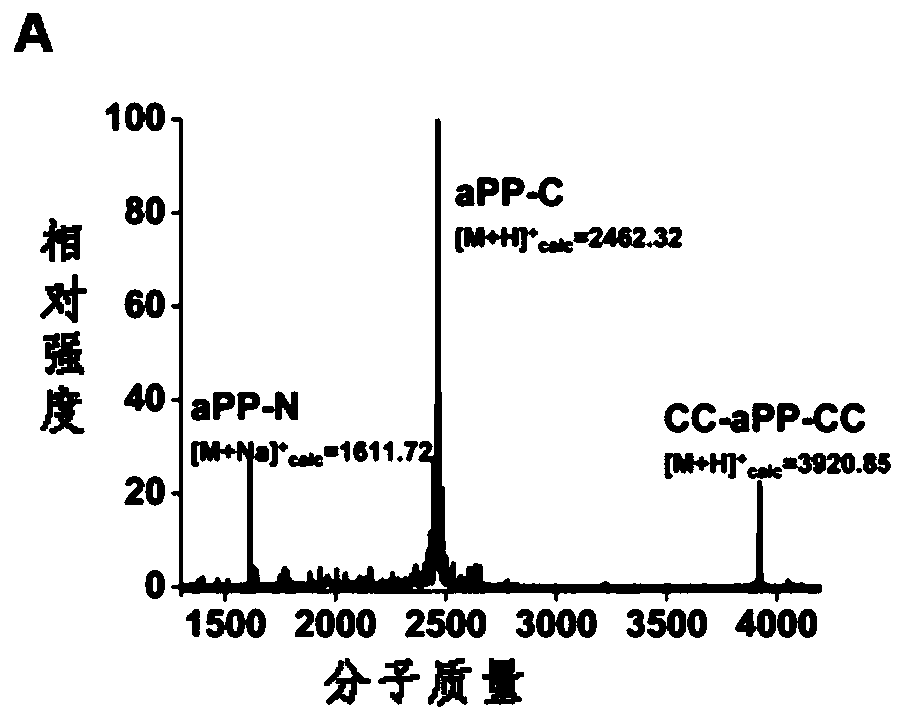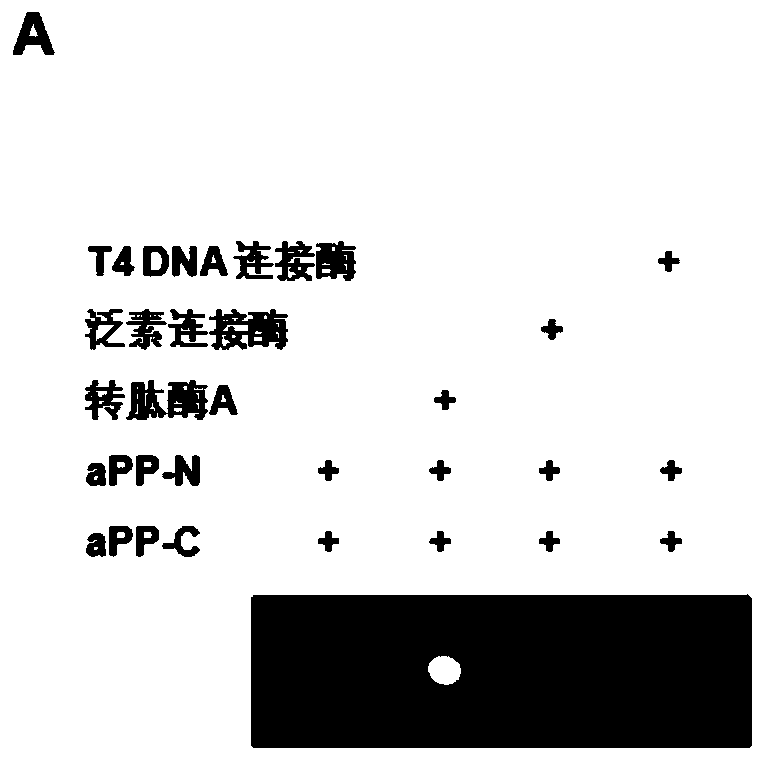Polypeptide probe pair for measuring transpeptidase alpha activity, method for measuring transpeptidase alpha activity and application of both
A technology of transpeptidase and transpeptidase reaction, which is applied in chemical instruments and methods, biochemical equipment and methods, and the determination/inspection of microorganisms. specific effect
- Summary
- Abstract
- Description
- Claims
- Application Information
AI Technical Summary
Problems solved by technology
Method used
Image
Examples
Embodiment 1
[0073] Embodiment 1 is used for measuring the design of the polypeptide probe pair of transpeptidase A activity
[0074] This embodiment provides a pair of polypeptide probes for measuring the activity of transpeptidase A, including a first polypeptide probe and a second polypeptide probe, and the two designed polypeptide probes are named aPP- N and aPP-C, wherein the amino acid sequence of aPP-N is: CCPSQPTYPGLPATGG (SEQ ID NO.1), and the amino acid sequence of aPP-C is: GGVEDLIRFYDNLQQYLNVCC (SEQ ID NO.2). Each probe contains three different functional regions: among them, LPATGG and GG will participate in the transpeptidase A-mediated transpeptidation reaction; CC is the site combined with arsenic dye to read the activity of transpeptidase A ; PSQPTYPG and VEDLIRFYDNLQQYLNV will bind to each other so that the two cysteine-cysteine doublets are spatially adjacent. The transpeptidation reaction mediated by transpeptidase A will form a new chimeric polypeptide whose amino a...
Embodiment 2
[0075] Embodiment 2 is used for measuring the performance measurement of the polypeptide probe pair of transpeptidase A activity
[0076] In order to determine whether transpeptidase A can catalyze aPP-N and aPP-C provided in Example 1 of the present invention to form CC-aPP-CC, this example adds 10 micromoles per liter of aPP-N, 40 micromoles per liter of a PP-C and 0.1 micrograms of transpeptidase A to 20 microliters of transpeptidation reaction buffer (50mM Tris·HCl, pH 7.5, 150mM NaCl, 5mM CaCl 2 and 1mM DTT) and incubated at 37°C for two hours. Subsequently, the ten-fold diluted reaction product was analyzed by matrix-assisted laser desorption ionization time-of-flight mass spectrometry, and the results were as follows: Figure 1A As shown, the transpeptidation reaction will generate a product with a molecular weight of 3920.85 Daltons, which is consistent with the theoretical molecular weight of CC-aPP-CC (3920.51 Daltons), indicating that transpeptidase A can recognize ...
Embodiment 3
[0077] Embodiment 3 is used for measuring the activity of the polypeptide probe of transpeptidase A activity in vitro quantitative determination of transpeptidase A
[0078] This example further verifies that aPP-N and aPP-C can specifically measure the activity of transpeptidase A through experiments. In this example, the linking effects of transpeptidase A, T4 DNA ligase and ubiquitin ligase on aPP-N and aPP-C were determined in the transpeptidation reaction buffer. The specific experimental operation is as follows: 10 micromoles per liter of aPP-N and 10 micromoles per liter of aPP-C were mixed with 0.1 micrograms of transpeptidase A, 0.1 micrograms of T4 DNA ligase and 0.1 micrograms of ubiquitin ligase in Incubate at 37 °C for two hours, then add the reaction mixture to 80 µl containing 0.4 µmol FlAsH-EDT per liter 2 Double arsenic dye labeling buffer (100mM Tris·Cl, pH 7.4, 75mM NaCl, 1mM EDTA, 1mM DTT, 0.05mM BAL), and incubated at room temperature for 30 minutes in th...
PUM
 Login to View More
Login to View More Abstract
Description
Claims
Application Information
 Login to View More
Login to View More - R&D
- Intellectual Property
- Life Sciences
- Materials
- Tech Scout
- Unparalleled Data Quality
- Higher Quality Content
- 60% Fewer Hallucinations
Browse by: Latest US Patents, China's latest patents, Technical Efficacy Thesaurus, Application Domain, Technology Topic, Popular Technical Reports.
© 2025 PatSnap. All rights reserved.Legal|Privacy policy|Modern Slavery Act Transparency Statement|Sitemap|About US| Contact US: help@patsnap.com



